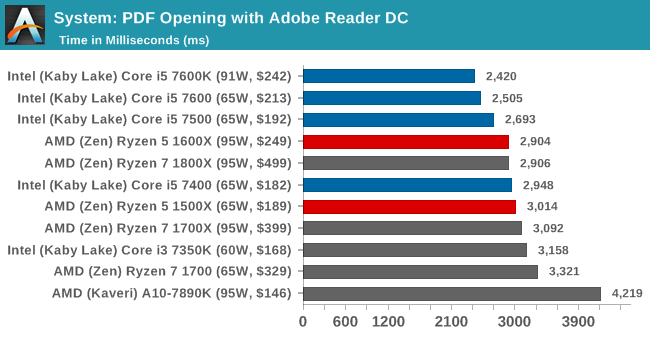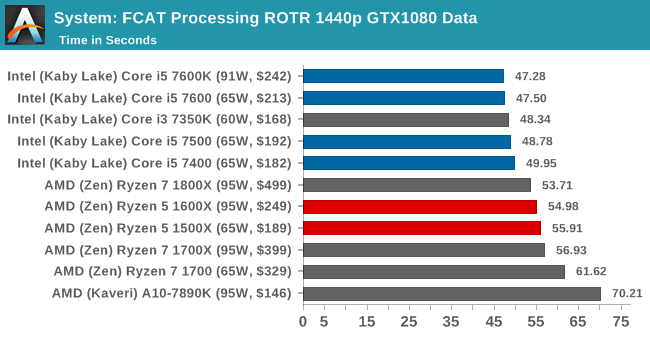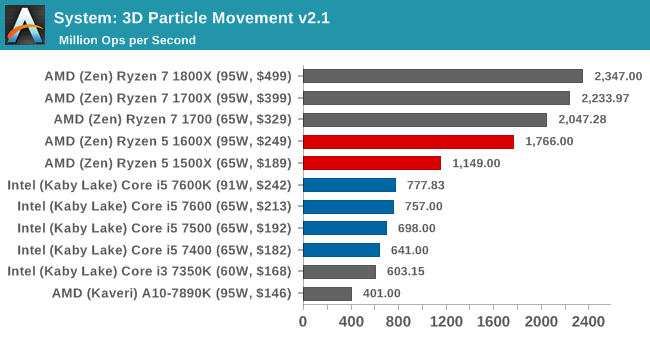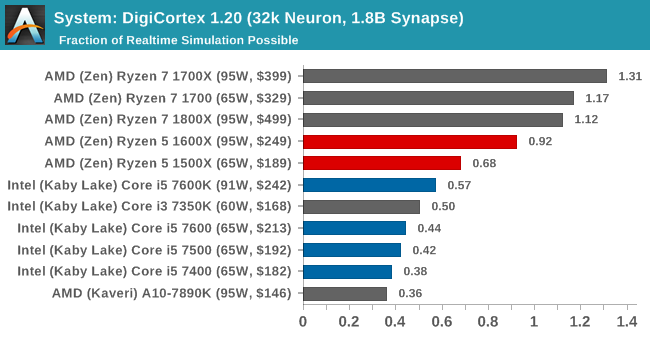The AMD Ryzen 5 1600X vs Core i5 Review: Twelve Threads vs Four at $250
by Ian Cutress on April 11, 2017 9:00 AM ESTBenchmarking Performance: CPU System Tests
Our first set of tests is our general system tests. These set of tests are meant to emulate more about what people usually do on a system, like opening large files or processing small stacks of data. This is a bit different to our office testing, which uses more industry standard benchmarks, and a few of the benchmarks here are relatively new and different.
PDF Opening
First up is a self-penned test using a monstrous PDF we once received in advance of attending an event. While the PDF was only a single page, it had so many high-quality layers embedded it was taking north of 15 seconds to open and to gain control on the mid-range notebook I was using at the time. This put it as a great candidate for our 'let's open an obnoxious PDF' test. Here we use Adobe Reader DC, and disable all the update functionality within. The benchmark sets the screen to 1080p, opens the PDF to in fit-to-screen mode, and measures the time from sending the command to open the PDF until it is fully displayed and the user can take control of the software again. The test is repeated ten times, and the average time taken. Results are in milliseconds.

Opening PDFs using Adobe is significantly single threaded, hence why Intel takes the win here for the most part - the 7400 is slightly lower on frequency, enough for the 4.0 GHz Ryzen parts to push ahead.
FCAT Processing
One of the more interesting workloads that has crossed our desks in recent quarters is FCAT - the tool we use to measure stuttering in gaming due to dropped or runt frames. The FCAT process requires enabling a color-based overlay onto a game, recording the gameplay, and then parsing the video file through the analysis software. The software is mostly single-threaded, however because the video is basically in a raw format, the file size is large and requires moving a lot of data around. For our test, we take a 90-second clip of the Rise of the Tomb Raider benchmark running on a GTX 980 Ti at 1440p, which comes in around 21 GB, and measure the time it takes to process through the visual analysis tool.
Similarly, FCAT is single threaded as it analyzes frame-by-frame. The extra frequency helps Intel here.
3D Particle Movement v2.1
This is the latest version of the self-penned 3DPM benchmark. The goal of 3DPM is to simulate semi-optimized scientific algorithms taken directly from my doctorate thesis. Version 2.1 improves over 2.0 by passing the main particle structs by reference rather than by value, and decreasing the amount of double->float->double recasts the compiler was adding in. It affords a ~25% speed-up over v2.0, which means new data.
DigiCortex 1.20
Despite being a couple of years old, the DigiCortex software is a pet project for the visualization of neuron and synapse activity in the brain. The software comes with a variety of benchmark modes, and we take the small benchmark which runs a 32k neuron/1.8B synapse simulation. The results on the output are given as a fraction of whether the system can simulate in real-time, so anything above a value of one is suitable for real-time work. The benchmark offers a 'no firing synapse' mode, which in essence detects DRAM and bus speed, however we take the firing mode which adds CPU work with every firing.
Agisoft Photoscan 1.0
Photoscan stays in our benchmark suite from the previous version, however now we are running on Windows 10 so features such as Speed Shift on the latest processors come into play. The concept of Photoscan is translating many 2D images into a 3D model - so the more detailed the images, and the more you have, the better the model. The algorithm has four stages, some single threaded and some multi-threaded, along with some cache/memory dependency in there as well. For some of the more variable threaded workload, features such as Speed Shift and XFR will be able to take advantage of CPU stalls or downtime, giving sizeable speedups on newer microarchitectures.

Because parts of Photoscan are very multithreaded, such as the first stage, there's plenty of scope for the Ryzen CPUs to pull ahead here.













254 Comments
View All Comments
Outlander_04 - Wednesday, April 12, 2017 - link
The information is out therehttps://www.youtube.com/watch?v=3VvwWTQKCZs
vladx - Wednesday, April 12, 2017 - link
That wasn't my point, readers shouldn't go elsewhere to compare with CPUs that are excluded due to bias.Meteor2 - Wednesday, April 12, 2017 - link
What relevance has a $340 CPU got to a $250 CPU review?vladx - Wednesday, April 12, 2017 - link
I'd say a ton more than the $499 Ryzen 7 1800x which didn't get excluded.psychobriggsy - Wednesday, April 12, 2017 - link
Yes, it's in the same product line, so people can see how it compares.Which seems to be roughly around 80% of the 1800X, for around half the price.
vladx - Wednesday, April 12, 2017 - link
And 7700k is more relevant for gaming which was the subject at hand so there you go.Meteor2 - Wednesday, April 12, 2017 - link
You didn't answer my question...vladx - Wednesday, April 12, 2017 - link
I just did, 7700k is more relevant than a 1800X in gaming benchmarks and as the competition it should've been included if a $499 CPU from AMD is included.psychobriggsy - Wednesday, April 12, 2017 - link
7700K is at a different price point, it rightly was compared in the Ryzen 7 reviews.Regardless, it would lose in the multithreaded benchmarks still, whilst having a small extra advantage in the gaming results.
vladx - Wednesday, April 12, 2017 - link
Ryzen 1800X is even more expensive than 7700k and yet got included in the gaming benchmarking, ironically considering 7700k is much more relevant for gaming.Sorry, but the bias and double standards are obvious in the article.